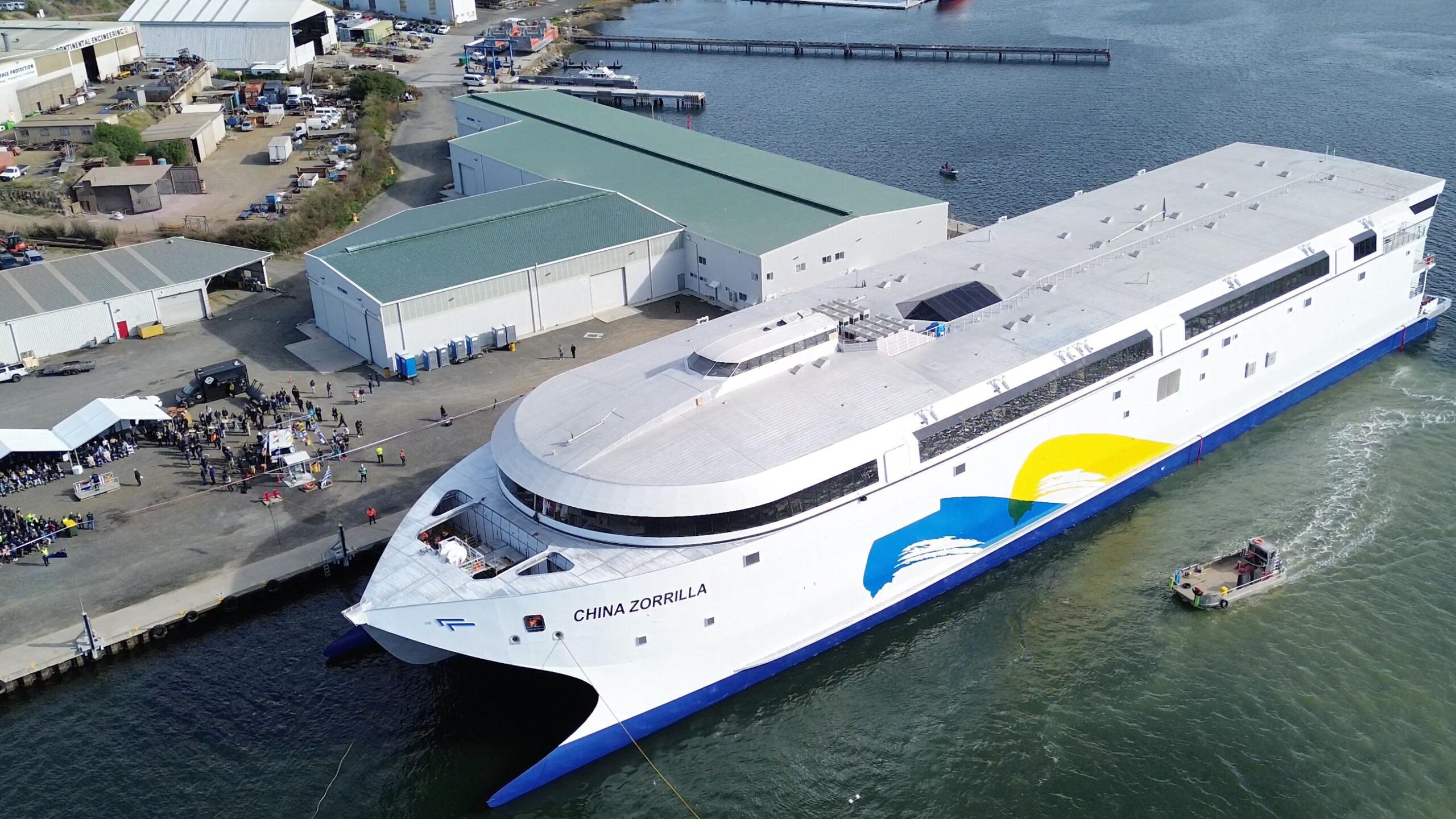
World’s Largest Electric Ship Launched in Australia, Signaling a Shift in Maritime Transport
An Australian shipbuilder, Incat, has officially launched what it claims is the world’s largest electric vessel, a colossal 130-meter catamaran capable of carrying over 2,000 passengers. This monumental project, dubbed Hull 096, marks a significant leap forward in the pursuit of sustainable maritime transportation and underscores the growing momentum towards decarbonizing the shipping industry.
The aluminum catamaran, built for South American ferry operator Buquebus, represents a substantial investment in electric propulsion technology. Powering this giant is a staggering 250-tonne battery system, providing a colossal 40 megawatt-hours of installed capacity. This enormous battery bank will allow the vessel to navigate the Río de la Plata estuary, connecting Buenos Aires, Argentina, with Uruguay, carrying up to 2,100 passengers and 225 vehicles per journey.
Stephen Casey, CEO of Incat, expressed his enthusiasm and confidence in the project, stating that the launch "proves that large-scale, low-emission transport solutions are not only possible, but they are ready now." The vessel was unveiled on the Derwent River in Hobart, Tasmania, a region renowned for its shipbuilding heritage.
The development and deployment of Hull 096 arrives at a critical juncture for the maritime industry. The International Maritime Organization (IMO) estimates that shipping accounts for nearly 3% of global greenhouse gas emissions, contributing significantly to global warming. This statistic has spurred increased scrutiny and pressure on the industry to adopt more sustainable practices.
The IMO has recently taken steps to address the issue, with member states voting in favor of a global pricing system aimed at reducing carbon emissions in the maritime sector. This agreement will require all ships to use a blend of lower-carbon fuels by 2028, or face financial penalties. This regulatory push is expected to accelerate the transition toward cleaner energy sources and innovative technologies within the shipping industry.
The launch of Hull 096 demonstrates the viability of electric propulsion as a solution for reducing emissions in maritime transport. While the initial investment in battery technology is substantial, the long-term operational cost savings and environmental benefits make it an increasingly attractive alternative to traditional fossil fuels. As battery technology continues to advance, with improved energy density and reduced costs, electric vessels are expected to become even more competitive in the market.
However, the transition to sustainable maritime transport is not without its challenges. While the IMO’s initiatives are a positive step, some environmental groups argue that the proposed solutions do not go far enough. Concerns have been raised regarding the potential reliance on biofuels, which could lead to other environmental problems, such as deforestation and land use change. Furthermore, some critics argue that a more aggressive approach is needed to achieve meaningful reductions in greenhouse gas emissions from the shipping industry.
The environmental impact of ship construction also warrants consideration. Aluminum, while being a relatively light and strong material, requires significant energy to produce. Therefore, the overall environmental footprint of the vessel needs to be assessed holistically, taking into account the energy used in its construction, operation, and eventual decommissioning.
Despite these challenges, the launch of Hull 096 represents a significant milestone in the development of sustainable maritime transport. It serves as a tangible example of what is possible with innovative technology and a commitment to reducing emissions. As the industry grapples with the urgent need to decarbonize, electric vessels like Hull 096 are paving the way for a cleaner and more sustainable future for shipping.
The integration of electric propulsion into larger vessels also poses engineering and logistical challenges. Designing a vessel that can accommodate such a massive battery system requires careful consideration of weight distribution, stability, and safety. Moreover, the charging infrastructure needed to support these vessels is still in its early stages of development. Ports and harbors around the world will need to invest in high-capacity charging stations to facilitate the widespread adoption of electric vessels.
Looking ahead, the success of Hull 096 will be closely monitored by the maritime industry. Its performance in real-world operations will provide valuable insights into the feasibility and scalability of electric propulsion technology for large vessels. The data collected on energy consumption, battery performance, and operational costs will inform future design decisions and investment strategies.
The ripple effect of this project could be significant. If Hull 096 proves to be a viable and cost-effective alternative to traditional ferries, it could encourage other ship operators to consider investing in electric vessels. This, in turn, would create a larger market for battery manufacturers and charging infrastructure providers, driving down costs and accelerating the adoption of electric propulsion technology across the maritime industry.
Furthermore, the development of electric vessels like Hull 096 can contribute to job creation in the clean energy sector. The design, construction, and maintenance of these vessels require specialized skills and expertise, creating new opportunities for engineers, technicians, and other skilled workers.
In conclusion, the launch of the world’s largest electric ship is a landmark achievement that signals a significant shift in the maritime industry. While challenges remain, the potential benefits of electric propulsion are undeniable. By embracing innovation and investing in sustainable technologies, the shipping industry can play a vital role in mitigating climate change and creating a cleaner and more sustainable future for all. The story of Hull 096 is not just about a single ship; it’s about the potential for a transformation in how we move goods and people across the world’s oceans and waterways.
